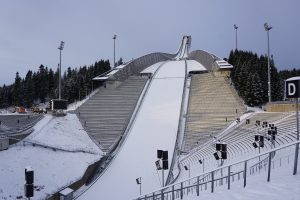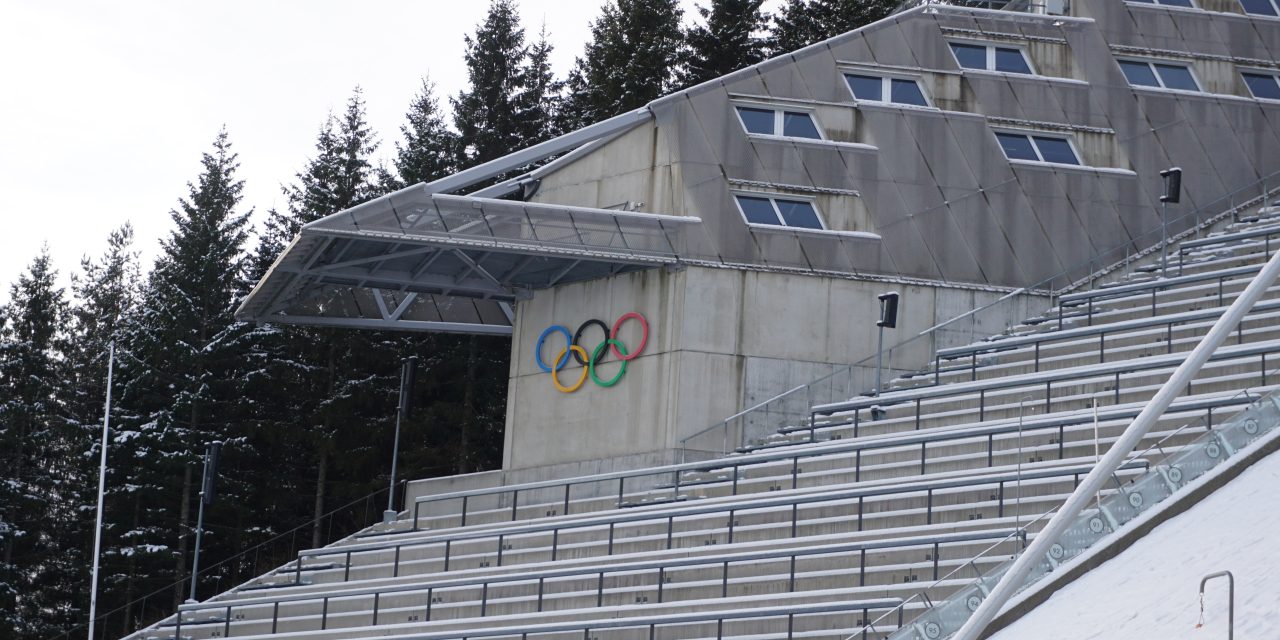With the Nordic combined, a traditional sport is on the brink of extinction because it does not fit into the gender-equality idea
of the IOC.
Gender equality, but only as long as it makes sense to us. The International Olympic Committee (IOC) announced on 23 June 2022 that there will be no women’s competition in Nordic Combined at the next Winter Olympics in Cortina in 2026, but at the same time they declared the 2026 Games to be the “most gender-equal games”. The contradiction is obvious.
Nordic Combined, a sport in which athletes first complete a jump from a ski jump and then enter a decisive cross-country competition based on the points scored, is the original Nordic skiing sport.
Sport rich in tradition
The discipline originated in Norway as early as the 19th century and has been Olympic since the first Winter Olympics in 1924. Over time, the Nordic combined became more and more popular and various competition formats emerged. Women did not play a role in public competitions in this sport for a long time. It was not until 2014 that there were official women’s competitions, from 2017 a Continental Cup – the second international class for men – and since 2020 a World Cup – the highest international competition series, also for men. Although the first staging of a women’s competition at the 2020 Youth Olympic Games was an important step in the sport’s development, the inclusion of women in the official Olympic programme is still a long time coming, although it would be very important for the discipline, its development and its continued existence.
Surprising IOC decision
The IOC justifies the decision not to give women a chance at the Olympics with the sport itself. In the last three Olympic Games, all medals were won by athletes from only four different nations. ” In addition, Nordic Combined had by far the lowest audience numbers during those Games” It therefore announced that the men would only be allowed to compete in 2026 because they were already in the Olympic cycle and preparing for the Games. This does not apply to the women, it said. If the women do not manage to become “good enough” and the men do not manage to become “interesting enough” for the Olympic Games, there would soon be no Olympic Nordic Combined competition at all.
To make this issue clear: Because the IOC’s goal is to become gender equal, the IOC would rather exclude the men of the competition than include the women, as they do not find the sport interesting enough.
The decision this summer was unexpected for the whole Nordic Combined community, not only the women, but also the men and everyone involved with the sport. “The IOC’s decision this summer was shocking for our entire sport,” says Jens Lurås Oftebro, himself a Nordic combined World Cup competitor. Everyone, not just the women, was disappointed. In an interview shortly before her training at the Trondheim Olympic venue, Mari Leinan Lund, Norwegian Nordic combined athlete, talks about the positive feeling of the athletes before the decision and the subsequent shock when things turned out differently than expected.
“The IOC’s arguments are comprehensible”. For her, for example, it is not only the nations that were on the podium at the last Olympic Games that count, but also those that were in the World Cup during the season.
Since the start of the women’s World Cup at the end of 2020, seven different nations have been on the podium, while for the men it has been 10 different nations since the start in 1983. In a recent interview, Eric Frenzel referred to the places from 15th onwards, because things had already changed there. The smaller nations had merely not yet reached the top ranks, often also due to financial difficulties. Ivar Stuan, Sports Director for Nordic Combined at the Norwegian Sports Federation, also thinks the IOC’s decision is wrong. The IOC did not comment on request.
Importance of the Olympic Games
Nordic combined, like any other sport, is in some way dependent on the Olympic Games. The whole development of the sport depends on it. “To stay part in the Olympics is crucial for our sport, looking at the reputation, interest, motivation, viewership and so on,” explains Jens Lurås Oftebro. From youth sports to professional sports, the Olympic Games are a big factor in determining the success, popularity and durability of a sport.
For the active athletes, participation in the Olympic Games not only means a great personal goal, but means attention for themselves and the sport. This brings sponsors and funds, which are necessary for the successful professional practice of a sport. In addition, there would be a lack of security that the sport would continue to exist on a professional level. If athletes can no longer afford to focus on the sport, the quality of the sport decreases and with it further public interest. It is a vicious circle that could have very complex consequences and mean the disappearance of such a tradition-rich sport. Then not only athletes are affected, but everyone who is part of what is currently (still) happening in the World Cup: Coaches, trainers, physiotherapists, people who take care of the equipment and so on. All because of alleged gender-equality.
From the small to the big

At Holmenkollen in Oslo is one of the oldest skijumping hills incuding a near by cross-country track – perfect conditions for the Nordic Combined athletes.
“This makes it hard to recruit new athletes. It’s important to see the sport on TV and at the Olympics,” says Ida Marie Hagen, herself a Nordic Combined athlete, about the lack of Olympic inclusion.
It starts on a small scale. Children sit in front of the TV during the Olympics, watching the athletes, possibly stars from their own country. They get excited about the sport and want to emulate the role models. A wish and a dream develop in the little child’s mind. The Olympic Games don’t even have to be the goal, but simply to jump and run like the Nordic combined athletes on TV. After a while, these children may develop into little talents themselves, who can later inspire little children in front of the television for their sport at big competitions like the Olympic Games.
It is a cycle of how the Olympics serves as a factor for popularity of a sport. “It could instead lead to a lack of motivation for the young talents and they could choose to become a ski jumper or a cross-country skier, which would be no good for our sport,” Oftebro adds.
Attention
The “No Exception” campaign was founded to draw attention to the discrimination against women Nordic combined athletes. The athletes want to draw attention to the fact that they should not be excluded, not be the only Olympic sport not to have a women’s competition.
The sign of the campaign is the cross-country ski poles crossed overhead to form an X. Athletes have shown this gesture together at past competitions before the start or individually, like Gyda Westvold Hansen, currently the best Nordic combined skier, at the finish. The athletes also draw attention to it on their social media channels under the campaign hashtag.
Ida Hagen emphasises in the interview that she has hope for the Olympics and that it would be possible if there was more “awareness and attention for it outside of the sport.” Her colleague Mari Lund also points out the importance of the campaign.
In addition, the sport should become more interesting for spectators again to eliminate another argument of the IOC. Revolutionising the sport completely to make it more interesting is unlikely, but Ida Hagen suggests varying the type of competitions more. The FIS Games could also generate attention in addition to the World Cup and World Championships, she thinks. The FIS Games are a proposal around which there is no debate about men’s and women’s Nordic Combined competitions. The FIS (Federatión International de Ski) is considering organising a competition with all the sports that fall under its umbrella, including cross-country skiing, alpine skiing and snowboarding.
In the end, however, sports also depend on the media to cover them in order to be seen. Jens Lurås Oftebro finds “…it is important that female and male athletes and all the media give attention and awareness to this topic and try to make the IOC realise that including women [in the Olympics, ed.] would be important for the growth of our sport.”
Future plans
Both the male and female Nordic Combined athletes will not admit defeat so easily. They support each other so that by 2030 at the latest, the women will also be part of the Olympic programme and the men will not have to fear either. Ida Hagen sums up the dilemma of the IOC decision: “The boys need the girls and the girls need the boys”.
A suggestion to get more nations into the World Cup to invalidate the IOC’s arguments came last year from FIS Race Director Lasse Ottesen with the “Nations helping Nations” programme. This would see the top five Nordic combined nations – Germany, Austria, Norway, Japan and Finland – each enter into collaborations with two to three smaller nations to advance and support their respective nations in sporting terms. Germany, for example, is planning to collaborate with the Swiss, Dutch and Italian federations. However, the collaboration will be individual for each nation.
Change of mind by the IOC for 2026 still possible?
Ivar Stuan, Sports Director for Nordic Combined at the Norwegian Ski Federation, is confronted daily with the development and continuation of the sport. But he has not yet given up hope for 2026 either, otherwise he would not be working for it every day, he says. “People can change their opinion. Everyone involved can and must do more,” including him, he points out in the interview. Everyone should do their best, talk and debate more about it, make the issue big and known. The biggest hurdle lies with the IOC, in his opinion, there are hardly any other major opponents of the development. The female athletes have not yet given up hope of their first Olympic Games in 2026 either. This winter, the athletes and the entire sport will be watched closely until the final decision is made by the IOC in June.




